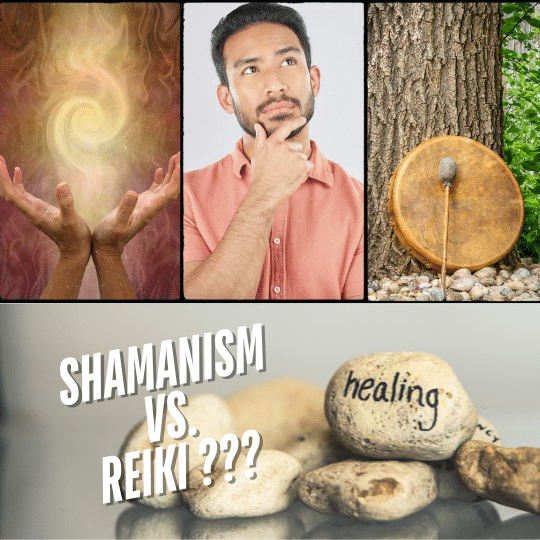Shamanic Healing vs. Reiki: My Experience as a Shamanic Practitioner
One of the most common questions I get as a shamanic practitioner is: “What is the difference between shamanic healing and Reiki?” As someone trained in both modalities, I have a deep appreciation for the benefits of Reiki. However, in my experience since 2010, I have consistently witnessed far more profound and life-changing results from shamanic healing.
Let me be clear: this isn’t about dismissing Reiki—it is a beautiful and effective healing practice that brings relaxation, balance, and stress relief. But the key differences in methodology and depth of healing mean that shamanic healing often creates deeper and longer-lasting transformations.
The Core Differences
Reiki: Gentle, Cumulative Energy Healing
Reiki is a Japanese energy healing practice developed in the early 20th century. It works by channeling universal life force energy through the hands, either in person or remotely. This energy helps restore balance to the body’s chakras, clear minor energetic blockages, and promote a sense of peace and well-being.
Reiki is wonderful for stress relief, emotional support, and general energy alignment. However, because Reiki works in a cumulative way, its effects are often temporary unless sessions are repeated consistently. Many Reiki practitioners recommend weekly or monthly sessions to maintain energetic balance.
Shamanic Healing: Deep, Transformational Work
Shamanic healing, on the other hand, is an ancient practice rooted in indigenous traditions worldwide. It works with spirit allies, power animals, ancestors, and natural elements to address deeper imbalances—those caused by soul loss, trauma, ancestral wounds, and energetic intrusions.
Unlike Reiki, which primarily channels universal energy, shamanic healing is interactive. As a practitioner, I journey to retrieve lost soul fragments, extract harmful energies, and communicate with the spiritual world to bring direct messages and healing for my clients. These sessions can be life-changing, creating long-term shifts that don’t necessarily require repeated sessions.
Shamanic Healing & Mainstream Recognition
In recent years, the mainstream medical community has begun to acknowledge the profound and lasting healing impacts of shamanic practices, particularly for individuals suffering from post-traumatic stress disorder (PTSD), including veterans and assault survivors.
- Shamanic Healing for PTSD: A case series published in PubMed explored shamanic healing for veterans with PTSD, finding it a feasible complementary approach for trauma recovery. (PubMed Study)
- Spiritual Recovery from Sexual Trauma: Research in the Journal of Interpersonal Violence highlights the role of spiritual practices, including shamanic elements, in the recovery of trauma survivors. (Sage Journals Study)
- Ritual Healing for Abuse Survivors: An analysis in JSTOR found that ritual healing, which often includes shamanic practices, provides substantial benefits in the recovery journey of abuse survivors. (JSTOR Study)
- Psychedelic-Assisted Therapy: Organizations like the Heroic Hearts Project report that 80% of veterans experience significant improvement after participating in shamanic-inspired psychedelic healing programs. (Heroic Hearts Project) Please Note – Please be sure that if you choose this path, that you are doing it with an organization that is legitimate, with a proven track record – speak to others who have used them and ensure that they have trained medical staff present during these sessions. While I have heard success stories regarding using psychedelics, I have also worked with clients who had VERY negative outcomes that left them worse off than before, thus requiring intensive and prolonged shamanic healing work to undo the damage and get the person on the path of healing once again. Be sure to do your homework on this type of therapy.
These studies and initiatives indicate a growing recognition of the value of shamanic practices in addressing severe trauma. While more research is needed, the integration of shamanic healing into therapeutic settings offers a promising avenue for those seeking profound and lasting recovery.
Which Healing Modality is More Powerful?
Power is relative to the needs of the individual. If you are looking for a gentle, ongoing practice to help with relaxation, stress relief, or emotional balance, Reiki may be an excellent choice. However, if you are struggling with deep-seated trauma, chronic emotional wounds, generational patterns, or a sense of spiritual disconnection, shamanic healing is often far more effective.
In my experience, Reiki can be a great supportive tool, but shamanic healing frequently leads to permanent, transformative shifts. Many of my clients come to me after trying other energy work—including Reiki—and find that shamanic healing provides the breakthrough they were seeking.
How to Choose the Right Modality for You
- Go with Reiki if you want regular, gentle energy balancing and relaxation. It’s excellent for stress, anxiety, and maintaining overall energetic health.
- Choose shamanic healing if you’re ready for deep, soul-level healing and transformation. If you feel stuck in recurring patterns, disconnected from yourself, or burdened by past trauma, this may be the path for you.
- Combine both for ongoing support. Reiki can help integrate and sustain the deep work done in shamanic healing.
Final Thoughts
I deeply respect both Reiki and shamanic healing, but after years of practice, I have personally seen shamanic work create the most profound and lasting change in my clients. If you’ve been searching for deeper healing and haven’t found the results you need with other modalities, I invite you to explore the power of shamanic healing.
If you have more questions or want to schedule a session, feel free to reach out. I’d love to support you on your healing journey.
— Deborah Blucher, The Wired Shaman
